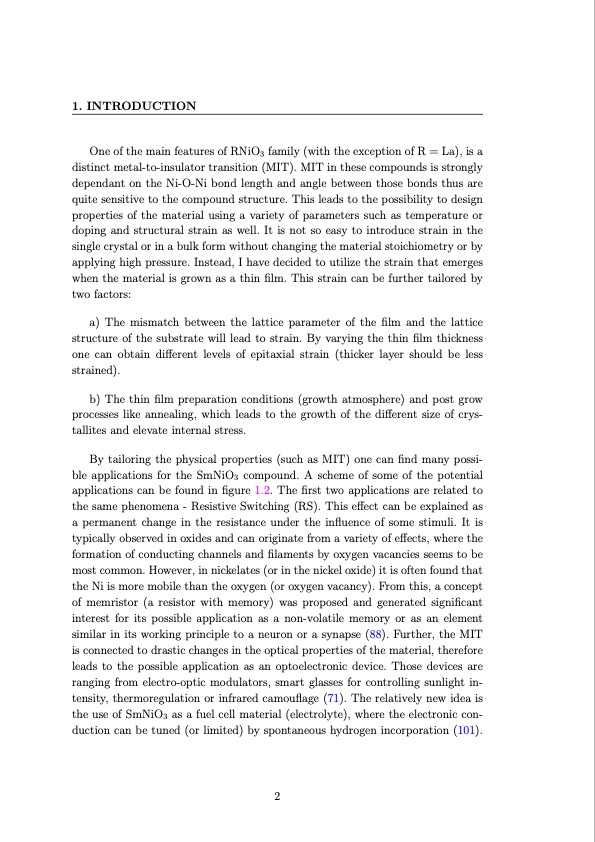
PDF Publication Title:
Text from PDF Page: 023
1. INTRODUCTION One of the main features of RNiO3 family (with the exception of R = La), is a distinct metal-to-insulator transition (MIT). MIT in these compounds is strongly dependant on the Ni-O-Ni bond length and angle between those bonds thus are quite sensitive to the compound structure. This leads to the possibility to design properties of the material using a variety of parameters such as temperature or doping and structural strain as well. It is not so easy to introduce strain in the single crystal or in a bulk form without changing the material stoichiometry or by applying high pressure. Instead, I have decided to utilize the strain that emerges when the material is grown as a thin film. This strain can be further tailored by two factors: a) The mismatch between the lattice parameter of the film and the lattice structure of the substrate will lead to strain. By varying the thin film thickness one can obtain different levels of epitaxial strain (thicker layer should be less strained). b) The thin film preparation conditions (growth atmosphere) and post grow processes like annealing, which leads to the growth of the different size of crys- tallites and elevate internal stress. By tailoring the physical properties (such as MIT) one can find many possi- ble applications for the SmNiO3 compound. A scheme of some of the potential applications can be found in figure 1.2. The first two applications are related to the same phenomena - Resistive Switching (RS). This effect can be explained as a permanent change in the resistance under the influence of some stimuli. It is typically observed in oxides and can originate from a variety of effects, where the formation of conducting channels and filaments by oxygen vacancies seems to be most common. However, in nickelates (or in the nickel oxide) it is often found that the Ni is more mobile than the oxygen (or oxygen vacancy). From this, a concept of memristor (a resistor with memory) was proposed and generated significant interest for its possible application as a non-volatile memory or as an element similar in its working principle to a neuron or a synapse (88). Further, the MIT is connected to drastic changes in the optical properties of the material, therefore leads to the possible application as an optoelectronic device. Those devices are ranging from electro-optic modulators, smart glasses for controlling sunlight in- tensity, thermoregulation or infrared camouflage (71). The relatively new idea is the use of SmNiO3 as a fuel cell material (electrolyte), where the electronic con- duction can be tuned (or limited) by spontaneous hydrogen incorporation (101). 2PDF Image | Investigation of metal-insulator transition in magnetron sputtered samarium nickelate thin films

PDF Search Title:
Investigation of metal-insulator transition in magnetron sputtered samarium nickelate thin filmsOriginal File Name Searched:
Bilewska_Investigation_of_metal_insulator_transition_in_magnetron_sputtered_samarium.pdfDIY PDF Search: Google It | Yahoo | Bing
Sulfur Deposition on Carbon Nanofibers using Supercritical CO2 Sulfur Deposition on Carbon Nanofibers using Supercritical CO2. Gamma sulfur also known as mother of pearl sulfur and nacreous sulfur... More Info
CO2 Organic Rankine Cycle Experimenter Platform The supercritical CO2 phase change system is both a heat pump and organic rankine cycle which can be used for those purposes and as a supercritical extractor for advanced subcritical and supercritical extraction technology. Uses include producing nanoparticles, precious metal CO2 extraction, lithium battery recycling, and other applications... More Info
| CONTACT TEL: 608-238-6001 Email: greg@infinityturbine.com | RSS | AMP |